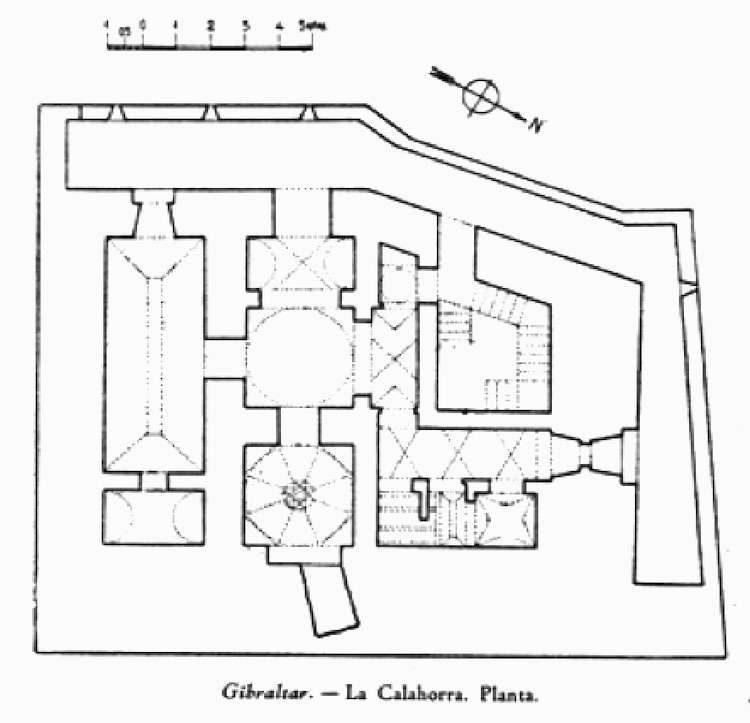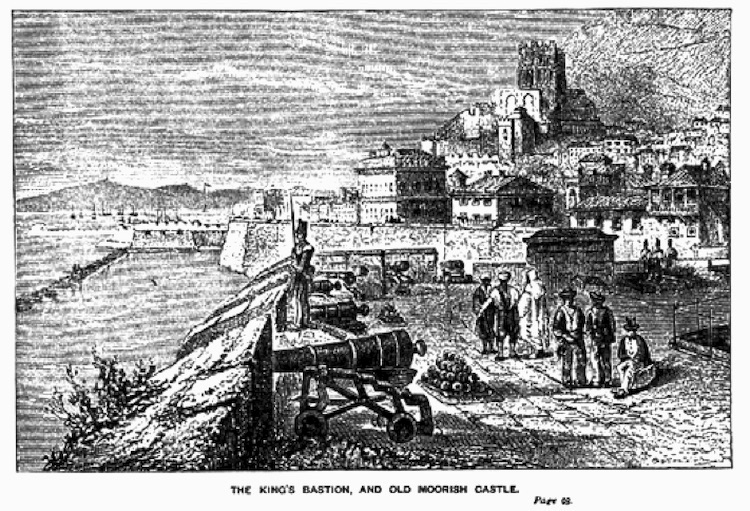In his history of Gibraltar published in 1946, Dr Howes, after consulting all the histories of Gibraltar in English that had appeared up to that date, decided that it had been built by Tarik in 711. Today we know that this is not true.
THE CITY WALLS IN THE XVI CENTURY
Although the chroniclers talk of Tarik having built a hisn (fortification) on the Rock of Gibraltar, historians have ignored the fact that he was in Gibraltar for less than six weeks . There were only seven weeks between his first landing on 27 April 711 and the Battle of Guadalete on 23 July, in which he defeated Roderick’s army. Therefore any fortifications he would have built would have been temporary whilst he assembled his army, which was being transported from Ceuta in the four small ships at his disposal
Thirdly, Francis Carter, in his book, A Voyage from Gibraltar to Malaga, published in 1772, tried to fix a definite date for the construction of the first permanent fortifications in Gibraltar, and through his scant knowledge of the history of the Moslem kingdom of Granada he arrived at a completely wrong date.
In 1843, the Spanish scholar Pascual Gayangos, whilst in political exile in England, translated The History of the Mohammedan Dynasties in Spain of Al Makkari into English. This book gave the story of how Abd al-Mumin had founded the city of Gibraltar. But this was a very scholarly book and its index in Arabic and scholarly transliterations into Latin characters made it difficult to refer to. So only one historian Frederic George Stephens quotes it in his book, A History of Gibraltar and its Sieges, published in 1870. All other historians, both Spanish and English, ignored this information, but modern scholars have delved more deeply into this question.

2580246
The French historian Étien Levi-Provençale researched the Moroccan state archives and in 1941, he published in the Paris journal Hesperis, ‘Trente-sept lettres officielles Almohades’, and one of these letters contains the instructions by Abd al-Mumin for the foundation of the new city of Madinath al-Fath on the Rock of Gibraltar. The text of this letter is given in Heritage Journal 2, page79.
It was left to Leopoldo Torres Balbás to write the definitive story of the foundation of Gibraltar. Torres Balbás was for many years the architect conservator of the Alhambra and he was great Arabist. In 1930, Governor Godley invited him to Gibraltar to investigate the Moorish baths in the newly opened Gibraltar Museum. Torres Balbás always intended returning to Gibraltar to continue his archaeological investigation but he was overtaken by events. When the Civil War broke out he was on holiday in the north of Spain, luckily for him, because if he had been in Granada he would probably have suffered the same fate as all the other liberal intellectuals there, and he would have been shot out of hand. But although he lived for another quarter of a century the Franco regime never allowed him to have a passport so that he could travel outside Spain because of his liberal antecedents.
Torres Balbás was therefore unable to make his second intended visit to Gibraltar, However, in 1942, he published in the journal Al-Andalus, in Madrid, the results of his research, in an article entitled ‘Gibraltar, llave y guarda de España’. In this article he employed all the known texts on Moslem Gibraltar, including Levi-Provençale’s monograph, the al-Makkari and the recorded visit of Ibn Battutah to Spain. This article appeared at a time when Spain was undergoing a period of great financial crisis as a result of the Civil War and the World war, and very few numbers of the journal were printed, and was ignored by English historians for many years. I was fortunate to obtain a copy from a Spanish friend who found a copy among her father’s possessions after his death and I referred to it in my article on Moslem Gibraltar in Heritage Journal 5, in1998.
Ibn Yuzzay, who was ibn Battutah’s editor adds this gloss to the traveller’s visit to Gibraltar, referring to its capture by the Moroccans in 1333:
‘Our Lord Abu’l Hassan (may Allah have mercy on his soul) built the huge tower which is now found on the highest part of the Kasbah; for before there was only a small one which had been ruined in the siege, and our lord constructed the vast tower in its place which I mentioned. He also built a dockyard and workshops in Gibraltar, which were lacking, and finally built the great wall which surrounds the red hill, and starts from the dockyard and stretches to the tile works (Red Sands).’
The remains of the small tower were incorporated into the massive solid structure that we know as the Moorish Castle, and traces of it have been discovered by archaeologists. It was always assumed that this small tower was part of the original fortifications of Abd-al Mumin’s time, but Manuel López Fernandez, (Heritage Journal 17, 2010) has found in the Chronicle of Fernando IV a statement that ‘otrosi mando labrar una torre encima del recuesto de la villa’ – he ordered the building of a tower on the hill above the town. In other words, there was no tower there before, but because that was the place that the Castillians had broken into the fortifications Fernando realised that this was the weakest point in the fortification and decided to strengthen it by building the tower. When the Moroccans attacked Gibraltar they attacked the same spot and therefore Abu’l Hassan decided that a stronger tower was required and he built what became the largest fortified Moslem tower in Spain.
How old is the Moorish Castle?
The answer is that the Tower of Homage dates from the middle of the fourteenth century and is about 660 years old, but the original fortifications date back to 1160 and are 850 years old. There is however one proviso, in 1068, al-Mu’tadid, king of Seville, fearing and invasion by the Almoravides of Morocco, ordered the governor of Algeciras ‘to build a fort on Gibraltar’. This was only to prevent a landing by the Moroccans and was probably the origin of the Torre del Tuerto at the New Mole, which the historian Portillo considered a very ancient construction.
The dating of the construction of the Moorish Castle has been bedevilled over the years by three misconceptions. First we refer to the Tower of Homage as the Moorish Castle and ignore the fact that the original fortifications, built all at one time, were much more extensive than that, they were not just an isolated castle but a fortified Kasbah.











